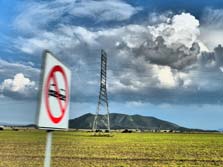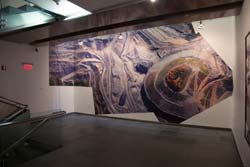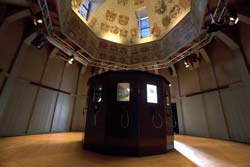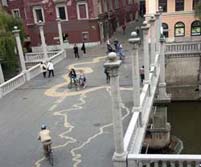PLEASE
SCROLL DOWN FOR THE ENGLISH VERSION
[macro]biologies I: the biosphere
Katya Gardea Browne
The Center
for PostNatural History
Mathias Kessler
Alexandra Regan
Toland
Kuratoren: Regine
Rapp & Christian de Lutz
Vernissage: Freitag, 7. März 2014, 20 Uhr
Laufzeit: 8. März – 4.
Mai 2014 (geschl. 18. – 20. April)
Öffnungszeiten: Fr-So,
14-18h (und nach Vereinbarung)
Standorte: Art Laboratory Berlin,
Prinzenallee 34, 13359 Berlin; Theatersaal, Prinzenallee 58, 13359
Berlin



von links nach rechts: Katya Gardea Browne, Mathias Kessler, The
Center for PostNatural History, Alexandra Regan
Toland
Anstatt eines
einheitlichen Konzepts der Existenz von “Welt” oder “Natur” sehen wir uns
heutzutage im postanthropozentrischen Zeitalter vielmehr von einer Vielzahl von
Strukturen, einer Verwischung von Grenzen sowie einer Wiederkehr des Objekts
konfrontiert. Diese Ausstellung ist der Auftakt unserer diesjährigen
Ausstellungsreihe [macro]biologies und [micro]biologies, die
aktuelle internationale künstlerische Positionen in diesem Bereich
vorstellt.
Für die Ausstellung
[macro]biologies I: the biosphere haben wir uns auf vier wichtige
internationale Künstlerinnen und Künstler konzentriert, die sich auf eine
äußerst interessante Weise mit den Strukturen und Systemen unserer Welt
auseinander setzen. Dabei stehen Ökosysteme und die Biosphäre mit Milliarden von
Wesen im Zentrum, die mit anderen Systemen ko-agieren (wie beispielsweise der
Geologie und dem Klima).
Die
international anerkannte, in Mexiko-Stadt lebende und arbeitende Künstlerin
Katya Gardea Browne hat sich auf die Bereiche Fotografie, Film, Video und
Objektkunst spezialisiert. Ihre Arbeiten beruhen meist auf langen,
prozessartigen Beobachtungen von Natur und Zivilisation an soziopolitischen
Grenzgebieten, zum Beispiel anhand der Megacity Mexiko D.F. Eine ihrer neuen
Videoarbeiten thematisiert die Zerbrechlichkeit der Ökosysteme am Beispiel von
Xochimilco, mit neuem und altem Filmmaterial, was wie eine „urbane Archäologie
fossiler Inseln“ anmutet.
Mehr Information: www.katyagardea.com/
Das Center for PostNatural History
versteht sich als Kunst- und Wissenschaftsprojekt (Direktor: Richard Pell,
Learning Science Advisor: Lauren Allen, Designer: Mason Juday) und bezieht sich auf Lebensformen, die durch den Menschen
bewusst manipuliert worden sind (z.B. Zähmung, Züchtung oder Genmanipulation).
Art Laboratory Berlin zeigt in der Ausstellung die Arbeit PostNatural
Organisms of the European Union, die (bewusst!) einem Museum gleicht und
dabei auf das Phänomen des Repräsentierens beispielhafter Biofakte anspielt
(z.B. Tulpenzüchtung aus dem 17. Jahrhundert oder Hundezüchtung).
Mehr
Informationen: www.postnatural.org
Der in New York
arbeitende Künstler Mathias Kessler beschäftigt sich unter anderem mit dem
Phänomen landschaftlicher Veränderungen durch Energiegewinnung. Radikale Formen
der Landabtragung hat er durch Luftaufnahmen am Beispiel eines Kohlebergwerks in
den Appalachian Mountains (US) dokumentiert. Dabei lenkt er den Blick auf die
menschliche Fähigkeit, die Erde nach Belieben zu formen, und damit auf die
katastrophalen Auswirkungen der modernenen Hybris. Speziell für diese
Ausstellung wird er den urbanen Raum Berlins miteinbeziehen.
Mehr
Information: www.mathiaskessler.com/index.html
Die in Berlin arbeitende Künstlerin
Alexandra Regan Toland setzt sich auf verschiedene Weise mit urbanen
biologischen Strukturen auseinander. Für die Ausstellung bei Art Laboratory
Berlin konzentriert sie sich auf das Thema Bodenversiegelung in Berlin: Sie wird
kartographische Dokumente und den Staub der Stadt verwenden, sowie Schuhprofile
auf die Abdrücke der Bodenversiegelung als auch die weiten Gehwege auf poröse
Oberflächen untersuchen.
Mehr Information: http://artoland.wordpress.com/
Presse:
Olga Shmakova
Kooperationspartner: degewo, fotoscout,
Genossenschaft PA58
Mit freundlicher
Unterstützung von:




Besonderer Dank an Michael Schröder für seine
großzügige Unterstützung.
Mediapartner:


Regine Rapp, Christian de
Lutz
Prinzenallee 34, 13359 Berlin
www.artlaboratory-berlin.org
info@artlaboratory-berlin.org
************************************
[macro]biologies I: the biosphere
Katya Gardea Browne
The Center for PostNatural
History
Mathias Kessler
Alexandra Regan
Toland
Curators: Regine Rapp
& Christian de Lutz
Opening: Friday, 7 March 2014, 8PM
Exhibition runs: 8 March – 4
May 2014
(closed on Easter weekend 18 – 20 April)
Open: Fri-Sun, 2-6 PM and by appointment
Venues: Art
Laboratory Berlin, Prinzenallee 34, 13359 Berlin; Theatersaal, Prinzenallee
58, 13359 Berlin



from left to right: Katya Gardea Browne, Mathias Kessler, The Center for
PostNatural History, Alexandra Regan Toland
Instead of a unified conception of existence, such as »world« or
»nature«, today, in the post-anthropocentric era, we find ourselves confronted
rather with a multiplicity of structures, a blurring of boundaries, and a
re-emergence of the object. This show is part of a series of
exhibitions – [macro]biologies and [micro]biologies –
dedicated to artistic reflection on current drastic changes to how we connect,
relate and interrelate to the worlds around us.
For [macro]biologies I: the biosphere we have chosen
four important international artists dealing with the structures and systems of
our world. The exhibition focuses on the ecosystem and the biosphere with
billions of life forms that interrelate with other systems, i.a. weather,
geology and climate.
The recent works
of Mexico City based artist, photographer and filmmaker Katya Gardea Browne have
stressed the cultural and environmental tensions between urban and rural, for
example in the megacity Mexico D.F. One of her new video works shows the
fragility of ecosystems using the example of Xochimilco with new and old film
footage, as »an urban archaeology of fossilized islands«.
More
information: http://www.katyagardea.com/
The Center for PostNatural History is an art and research
project (Director: Richard Pell, Learning Science Advisor: Lauren Allen,
Designer: Mason Juday) dealing with the history of mankind’s manipulation
of life forms, from early agriculture to genetic modification. Art Laboratory
Berlin will present the work PostNatural Organisms of the European
Union a form of museum representing biofacts of living, preserved and
documented organisms (e.g. tulip cultivation from the 17th century or dog
breeding).
More informationen: www.postnatural.org
New
York based artist Mathias Kessler’s aerial photography and documentation of
mountain top removal coal mining in the Appalachian Mountains focuses attention
on the human ability to shape the very Earth around us, but also to the
disastrous consequences of modern hubris. His special presentation for this show
will combine its original rural context with Berlin’s urban space.
More
information: http://www.mathiaskessler.com/index.html
Berlin based artist Alexandra Regan Toland
works on multiple levels to create social awareness about urban ecological
systems. For the exhibition she will use cartographic documents, urban dust, and
a collection of shoe profiles to examine the pressures of soil sealing (i.e. the
widespread pavement of porous surfaces) on human and non-human biological
communities in Berlin.
More information: http://artoland.wordpress.com/
Presse: Olga Shmakova
Cooperation partners:
degewo, fotoscout, Genossenschaft PA58
Supported by:




This exhibition is made possible in part by a
generous gift from Michael Schröder.
Media
partner:


Regine Rapp, Christian de
Lutz
Prinzenallee 34, 13359 Berlin
www.artlaboratory-berlin.org
info@artlaboratory-berlin.org